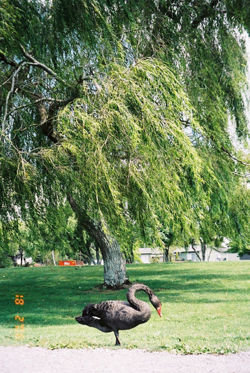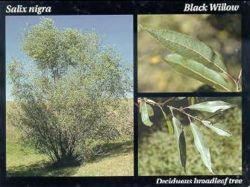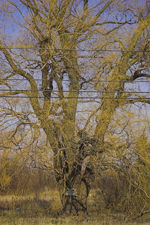Black willow
| Black willow |
|---|

|
| Scientific Classification |
|
| Salix nigra |
|
Bold text |
The Black willow is a species of willow from the Family Salicaceae.
Anatomy
The Black willow tree is 140 ft (43m)tall with 4 ft (1.2m)diameter.
The willow tree has no taste, but the root has a little bitter taste.
The Black willow's Leave shape is usually alternate and thin shape.
The leave is 0.37 in ~ 0.5 inch long in wide.
The Black willow's root can be grow up 70 ~ 80 feet in good condition
The Root has is used for medicine of tonics to purge the blood
The Black willow tree has both male and female flowers
Reproduction
Black willow is dioecious (having separate male and female plant)s. No consistently reliable morphological characteristics are associated with the identification of the sexes, which are indistinguishable except during flowering and seed development.
The Black willow also uses vegetative reproduction, a form of asexual reproduction in plants, in which multicellular structures become detached from the parent plant and develop into new individuals that are genetically identical to the parent plant. For example, liverworts and mosses form small clumps of tissue (called gemmae) that are dispersed by splashing raindrops to form new plants. Bulbs, corms, offsets, rhizomes, runners, suckers, and tubers are all important means of vegetative reproduction and propagation in cultivated plants. [2] [3]
Ecology
The Black willow’s native habitat is eastern North America, Nova Scotia, South Ontario, west Nebraska, South east of Arizona and Florida, and north-east of Mexico. Usually the species of willows are found in wet place such as streams, swamps, and lakes, sometimes in pure stands. [4] [5]
Uses of Black Willow
The black willow wood has light and flexible characteristic, and the old people used black willow woods to make toys before plastic had been dicovered.[6]
Related References
- Black Willow Forestry
- Anatomy of Black Willow ostermiller
- Uses of Black Willow Wikipedia
- Reproduction J. A. Pitcher and J. S. McKnight's paper
 Browse |

